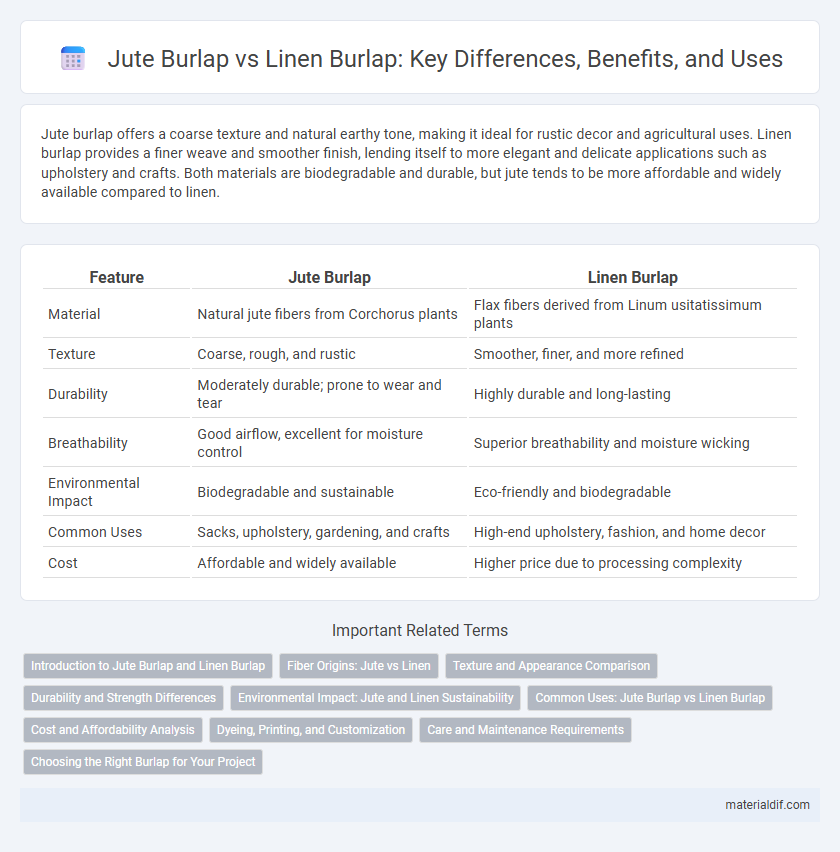Jute burlap offers a coarse texture and natural earthy tone, making it ideal for rustic decor and agricultural uses. Linen burlap provides a finer weave and smoother finish, lending itself to more elegant and delicate applications such as upholstery and crafts. Both materials are biodegradable and durable, but jute tends to be more affordable and widely available compared to linen.
Table of Comparison
| Feature | Jute Burlap | Linen Burlap |
|---|---|---|
| Material | Natural jute fibers from Corchorus plants | Flax fibers derived from Linum usitatissimum plants |
| Texture | Coarse, rough, and rustic | Smoother, finer, and more refined |
| Durability | Moderately durable; prone to wear and tear | Highly durable and long-lasting |
| Breathability | Good airflow, excellent for moisture control | Superior breathability and moisture wicking |
| Environmental Impact | Biodegradable and sustainable | Eco-friendly and biodegradable |
| Common Uses | Sacks, upholstery, gardening, and crafts | High-end upholstery, fashion, and home decor |
| Cost | Affordable and widely available | Higher price due to processing complexity |
Introduction to Jute Burlap and Linen Burlap
Jute burlap is a natural fiber fabric made from the jute plant, known for its coarse texture, durability, and eco-friendly properties, commonly used in agriculture and home decor. Linen burlap, derived from flax fibers, offers a smoother texture and increased strength, making it suitable for high-end crafts and upholstery. Both materials provide biodegradable and renewable alternatives, with jute burlap favored for rustic appeal and linen burlap prized for its fine weave and softness.
Fiber Origins: Jute vs Linen
Jute burlap is derived from the natural fibers of the jute plant, primarily grown in India and Bangladesh, known for its coarse texture and durability. Linen burlap originates from the flax plant, cultivated mainly in Europe, offering a finer, smoother fiber with enhanced strength and natural luster. The distinct fiber origins impact the texture, strength, and biodegradability of jute burlap versus linen burlap, influencing their applications in packaging, upholstery, and eco-friendly products.
Texture and Appearance Comparison
Jute burlap features a coarse, rough texture with a natural, earthy appearance characterized by its uneven fibers and rustic brown color. Linen burlap, made from flax fibers, offers a smoother, finer texture and a lighter, more refined appearance with tones ranging from off-white to beige. The distinct differences in fiber composition result in jute burlap being more robust and textured, while linen burlap presents a sleek, elegant finish suitable for decorative applications.
Durability and Strength Differences
Jute burlap offers moderate durability and tensile strength, making it suitable for light to medium-duty applications such as packaging and gardening. Linen burlap exhibits superior durability and higher tensile strength due to its fiber composition, providing enhanced resistance to wear and tear in heavy-duty uses. The natural stiffness of linen fibers contributes to longer lifespan and better structural integrity compared to the more flexible, coarser jute fibers.
Environmental Impact: Jute and Linen Sustainability
Jute burlap boasts superior environmental benefits due to its rapid growth cycle and minimal need for pesticides, making it a highly renewable resource with low carbon emissions. Linen burlap, derived from flax, also offers sustainability through its biodegradability and efficient water usage, but flax cultivation generally requires more time and care compared to jute. Both materials decompose naturally without leaving harmful residues, yet jute's faster renewability translates to a smaller overall ecological footprint in textile production.
Common Uses: Jute Burlap vs Linen Burlap
Jute burlap is commonly used for agricultural purposes such as crop protection, soil erosion control, and packaging due to its coarse texture and durability. Linen burlap, made from flax fibers, is favored for decorative applications like upholstery, crafts, and textile projects because of its smoother finish and refined appearance. Both materials serve key roles in gardening and crafts, but jute prioritizes strength and biodegradability while linen emphasizes aesthetic quality.
Cost and Affordability Analysis
Jute burlap is significantly more cost-effective than linen burlap, making it a preferred choice for budget-conscious projects due to its lower production costs and widespread availability. Linen burlap, derived from flax fibers, tends to be more expensive because of its labor-intensive processing and higher-quality texture, appealing to premium markets. When evaluating affordability, jute burlap offers optimal value for large-scale applications, whereas linen burlap suits niche uses where durability and aesthetics justify the higher price.
Dyeing, Printing, and Customization
Jute burlap offers superior dye absorption due to its coarse, fibrous texture, enabling vibrant and long-lasting colors ideal for rustic designs. Linen burlap features a smoother surface that allows finer printing details and more precise customization, suitable for intricate patterns and delicate hues. Both materials support eco-friendly dyeing processes, but jute's natural coarseness enhances durability, while linen provides a refined finish for premium custom applications.
Care and Maintenance Requirements
Jute burlap requires gentle handling to prevent fraying and should be cleaned through spot cleaning or dry cleaning to maintain its natural fibers and texture. Linen burlap offers greater durability and resistance to moisture, allowing for more frequent washing with mild detergents and air drying without compromising fabric integrity. Both materials benefit from avoiding prolonged exposure to direct sunlight to prevent fading and weakening of fibers.
Choosing the Right Burlap for Your Project
Jute burlap is a durable, biodegradable fabric ideal for gardening, crafts, and rustic decor due to its coarse texture and natural golden-brown color. Linen burlap offers a smoother, finer weave with a lighter color, making it perfect for upholstery, fashion, and home decor where a refined appearance is desired. Selecting the right burlap depends on the project's need for durability versus elegance, with jute favored for heavy-duty use and linen chosen for aesthetic appeal.
Jute Burlap vs Linen Burlap Infographic

 materialdif.com
materialdif.com